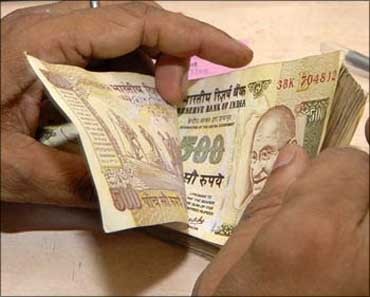Masoom Gupte in Mumbai
Volatility has become the buzzword for the markets, making retail investors wary of direct equity participation.
Some, however, are willing to try every strategy available to cash in on any window of opportunity. One such window being the 'pair strategy'.
The reason for its attractiveness: "It is a market-neutral strategy. And, it works regardless of the direction of the markets - trending downwards, upwards or sideways. Mostly, the strategy focuses purely on the price movement of scrips and not any fundamental," says Prashant Prabhakaran, president, retail broking, IIFL.
...
How to combine your gains in volatile times
The underlying instruments in the strategy could be equity (cash, futures and options), commodities or even currencies.
The strategy will work in the cash segment only if you are holding either of the stocks. In the options segment, while the pair strategy is possible, it is quite complicated and requires a large transactional amount, carried out via algorithmic-based trading.
Similarly, theoretically, it is possible to apply the strategy in commodities (pairs such as gold and silver or copper and nickel), as well. But taking a punt on these is deemed risky.
"Commodity prices are also governed by international events, making it difficult to establish a definite co-relation between their price movements," explains Sudip Bandopadhyay, president, Destimoney Securities.
...
How to combine your gains in volatile times
Working the strategy
Its mainstay is identifying two scrips, whose price movement is correlated. These would mostly belong to the same sector or sub-sector. Technical analysts study the price movements of these pairs in relation to each other over a specific period of time.
This duration would depend on an analyst's view with regard to the time period essential for establishing a trend. And, based on this analysis, a 'ratio' is established, between the price differential between both the scrips.
At times, this ratio increases or decreases due to events such as results, whereby one company posts very good results while other doesn't, or bulk trading that drives up prices of one stock vis-a-vis another, thus breaking the parity between the two.
...
How to combine your gains in volatile times
Such events open up an opportunity to trade as the assumption is that the stocks prices will move again (up or down as the case may be), such that the ratio is re-established.
Let us understand this with an example. Consider two stocks, A and B. Of these, A is a strong performer and B is trailing behind.
Now, the price of A starts moving up and that of B starts falling. According to the pair strategy hypothesis, this spread or difference between prices is abnormal. Their prices will converge in future, such that the normal ratio is re-attained.
...
How to combine your gains in volatile times
Here, investors must sell (short) the higher-priced stock (A) and buy (long) the lower-priced stock (B).
Assuming that A will correct in future and B will gain, allowing investors to make profits through both the transactions.
If the difference has decreased, the reverse must be done - sell the lower-priced and buy the higher one.
"While choosing the pair, ensure that both scrips are liquid, making it simpler to square off the positions," says Jayant Pai, vice-president, Parag Parikh Financial Services.
Reason: futures contracts may not be necessarily available for all stocks, and are sold in fixed lot sizes. While lot sizes vary from stock to stock, the value typically ranges from Rs 2-2.5 lakh for each lot. The margin money is five per cent or more, depending on the stock.
...
How to combine your gains in volatile times
Difficulties in execution
The primary challenge for adopting such a strategy lies in identifying the pair itself. Either you could depend on the view of the technical analysts or study the price movement independently.
The most prominent one is working out the futures lots sizes and ensuring both legs of the trades are approximately the same size.
Ideally, both legs of the transaction should be equal in cost. For example, you may have to sell two lots of Stock A for every three lots of Stock B bought. This may be cumbersome to execute.
...
How to combine your gains in volatile times
Another problem, as Prabhakaran points out, "The pair strategy is based on historical price movement of scrips in tandem. Positions taken based on this could go completely wrong. The stock prices could diverge further and even if they do converge, it may not happen in the said ratio."
Such a situation could be averted by setting tight stop losses, to cap any downside risks. Little wonder, the strategy is not recommended for small investors.
It is suited for those with a substantial investible surplus and who can devote time to tracking these investments.









article